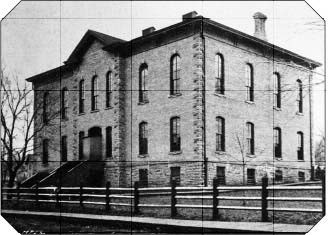Betsy-Tacy (8 page)
Authors: Maud Hart Lovelace

T
HEY APPROACHED the chocolate-colored house from the rear for it faced on Pleasant Street. On the back lawn was an oak tree which stood on a small knoll. On the knoll they saw what looked like a clothes pin, standing prongs up. It was a little girl standing on her head.
She righted herself when they came near and stood on her bare feet. She was dainty and small.
Her arms, legs and face were tanned, which made her blue eyes look even bluer than they were and her short fluff of yellow hair look very yellow. She stared at them silently out of her round blue eyes.
“What were you doing?” asked Betsy.
“Standing on my head.”
“What were you doing that for?”
“I was practicing.”
“It must be hard,” said Betsy.
“Oh, no, it isn't.” The little girl looked surprised.
Tacy didn't say a word. She was bashful.
Betsy stared back at the little girl. It was certainly Tib. “But my sister said you had a white lace dress on,” she said at last.
“I took it off when I came home,” Tib answered. “I'm not allowed to play in my best dress.”
“Neither am I,” said Betsy. “Neither is Tacy. I wish we could see your dress, though,” she added after a moment.
“Do you?” asked Tib, looking surprised again. “I'll show it to you.”
She led the way into the chocolate-colored house.
They went in by the back door. “Wipe your feet,” said Tib, pausing on the doormat. The kitchen was so cleanâ¦it shone like a polished pan. It smelled good, of something baking. A hired girl was standing by the stove.
There was a swinging door which led into the dining room and another door which led into a pantry full of glittery china and glass. The third door led up some narrow stairs and up these they followed Tib.

Upstairs was a long hall with doors admitting to the bedrooms.
Tib took them into one of these, and hanging in a closet was the white lace dress.

“It's a beautiful dress,” said Betsy.
Tacy touched one of the pale blue satin bows.
Tib led them down the hall. There were front stairs as well
as back stairs! They went down the front stairs, and just as the steps turned at a little landing, they came in view of the pane of colored glass. The afternoon sunlight, streaming through it, turned it to ruby red.
“Tacy and I like that colored glass,” said Betsy.
“What colored glass?” asked Tib.
“That colored glass over your door.”
“Do you. Why?” asked Tib. She looked at it as though she had never noticed it before.
“We like your tower too,” said Betsy.
“What tower?” asked Tib. “Do you mean the round room? That's our front parlor.”
They crossed the hall and entered it.
It was round and beautiful. Hanging over the piano was a picture of an old man giving a little girl a music lesson. The chairs and sofa were covered with blue velvet and there was a bamboo table draped with a blue silk scarf. The table held two little china dolls, a shepherd and a shepherdess.
Tib led them through blue velvet curtains into the back parlor. This had a window seat from which you could see the red brick schoolhouse. A lady sat there sewing. She was short and chunky and had yellow hair like Tib's and earrings in her ears.
“Is this the little Ray girl?” she asked.
“Yes, ma'am,” answered Betsy. “I'm Betsy and this is Tacy.”
Tacy held her head down and covered her face with her curls.
“Well, I hope you children will all be good friends,” Tib's mother said, smiling.
“Mamma,” said Tib. “May we have some coffee cake?”
“Yes,” said the lady. “Matilda will give you some. But eat it out on the knoll.”
So Matildaâshe was the hired girlâgave them some coffee cake. It was hot out of the oven. And they sat down to eat it on the knoll.
Tib kept staring at Betsy and Tacy with her round blue eyes. She looked awed and admiring, which was nice but very strange. For Tib was the one who danced, thought Betsy. She was the one who had a white lace dress. She was the one who had a house with front and back stairs and a tower and a pane of colored glass.
Betsy and Tacy looked at each other. Both of them looked surprised. They hadn't expected to like her, but they did.
Tib didn't say a word and neither did Tacy, so at last Betsy said:
“When you came to our house, we were up on the Big Hill.”
“Were you?” asked Tib.
“We climbed to the very top,” said Betsy.
“Did you?” Tib replied.
“There's a little hill too,” said Betsy. “With a bench on it. We eat our supper there.”
“All by yourselves?” asked Tib.
“All by ourselves,” said Betsy.
“And Betsy makes up stories,” said Tacy. It was the first word she had said.
“Do you mean,” asked Tib, “that she tells about Cinderella?”
“No, I make them up,” said Betsy.
“But how can you?” Tib asked.
“Why, I just do,” said Betsy. “Tacy helps me.”
“Will you make one up now?” asked Tib.
“Yes, if you want me to. I'll make one up about you and me and Tacy and that pane of colored glass over your door.”
Tib was speechless with astonishment, but Tacy jumped to her feet and said:
“Let's go up to our bench. That's the best place for stories.”
So she took one of Tib's hands and Betsy took the other. And they walked through the vacant lot and up Hill Street Hill.
As they walked they were very busy talking.
“We've got a piano box we play in,” Betsy said.
“And Betsy's got a baby sister,” Tacy said.
“We play paper dolls,” said Betsy.
“And store,” said Tacy.
“We dress up and go calling.”
“And Betsy makes up games.”
Tib held their hands tightly. She sighed deeply with content.
“I'm glad I came here,” she said. “I like this better than Milwaukee.”
Betsy and Tacy stopped still. They looked at each other, their eyes as round as Tib's. She liked Hill Street better than Milwaukee! Well, they had always known it was nice.
After a silent moment they went slowly on toward the bench on the hill.
“We'll have lots of fun,” said Betsy. “You and me and Tacy. Lots of things will happen.”
And so they did.
THE END

Â
Â
M
AUD
H
ART
L
OVELACE
was born on April 25, 1892, in Mankato, Minnesota. Like Betsy, Maud followed her mother around the house at age five asking questions such as “How do you spell âgoing down the street'?” for the stories she had already begun to write. Soon she was writing poems and plays. When Maud was ten, a booklet of her poems was printed; and by age eighteen, she had sold her first short story.
The Hart family left Mankato shortly after Maud's high school graduation in 1910 and settled in Minneapolis, where Maud attended the University of Minnesota. In 1917, she married Delos W. Lovelace, a newspaper reporter who later became a popular writer of short stories.
The Lovelaces' daughter, Merian, was born in 1931. Maud would tell her daughter bedtime sto
ries about her childhood, and it was these stories that gave her the idea of writing the Betsy-Tacy books. Maud did not intend to write an entire series when
Betsy-Tacy
, the first book, was published in 1940, but readers asked for more stories. So Maud took Betsy through high school and beyond college to the “great world” and marriage. The final book in the series,
Betsy's Wedding
, was published in 1955.
The Betsy-Tacy books are based very closely on Maud's own life. “I could make it all up, but in these Betsy-Tacy stories, I love to work from real incidents,” Maud wrote. “The Ray family is a true portrayal of the Hart family. Mr. Ray is like Tom Hart; Mrs. Ray like Stella Palmer Hart; Julia like Kathleen; Margaret like Helen; and Betsy is like me, except that, of course, I glamorized her to make her a proper heroine.” Tacy and Tib are based on Maud's real-life best friends, Frances “Bick” Kenney and Marjorie “Midge” Gerlach, and Deep Valley is based on Mankato.
In fact, so much in the books was taken from real life that it is sometimes difficult to draw the line between fact and fiction. And through the years, Maud received a great deal of fan mail from readers who were fascinated by the questionâwhat is true, and what is made up?
I
N THE SPRING OF
1897, Maud Hart and Frances “Bick” Kenney met at Maud's fifth birthday party and became lifelong friendsâjust like Betsy and Tacy. As Maud wrote to Bick Kenney's granddaughter in 1960, when she was sixty-eight years old, “Tacy certainly is your red-haired grandmother and has been my dearest friend ever since my fifth birthday.”
In the story, Betsy thinks Tacy is calling names when she first introduces herself because her name is so unusual. (Maud first discovered the name “Tacy” in a colonial newspaper when she was doing research for another book.) We don't know if this happened in real life, but it's possible that a similar misunderstanding resulted when Bick told Maud
her
name, which is also a bit unusual. Bick Kenney's niece explained the origin of the nickname: “Frances Kenney had very red hair as a child and was called âBrick.' Not being old enough to pronounce it properly, she called herself âBick.'” And Bick is the name she used throughout her life.
Â
Â
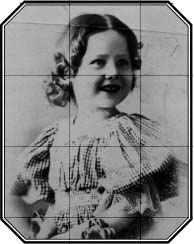
All three portraits from the collection of Susan Ryder
Maud's straight hair was curled for these photographs, taken for the occasion of her fifth birthday
.
Â
Â
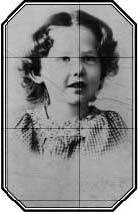
Â
Â
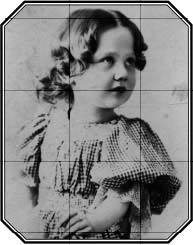
Â
Â

Lois Lenski probably referred to the photos when she drew Betsy in her special party dress
.
Â
Â
Maud seemed to recall the occasion of her fifth birthday very vividly, and much of the description
of the party in the book was based on her memories. For example, she remembered that she wore a “checked silk [dress] in tan, rose, and cream,” like Betsy's. And Bick really did bring Maud a little glass pitcher as a birthday gift. Although its gold-painted rim has now worn away, the pitcher can be seen today in the Maud Hart Lovelace wing of the Minnesota Valley Regional Library in Mankato, Minnesota.
In fact, Betsy and Tacy's adventures throughout the book are based on Maud's real childhood experiences. In an interview, Maud described some of the games she and Bick used to play, which will sound very familiar: “We used to color sand and put it in bottles and have sand stores and sell it. We cut our paper dolls out of the magazines. We dressed up in our mothers' long skirts. We went on picnics.”
In 1897, there really was a bench on the hill at the top of the street where Maud and Bick ate their suppers, although it was gone by 1906 or 1907. But readers may be pleased to know that a memorial bench was placed there in 1989, and it is still there todayâa testimony to the powerful effect of Maud's writing, and in commemoration of a very special friendship.
Â
Â
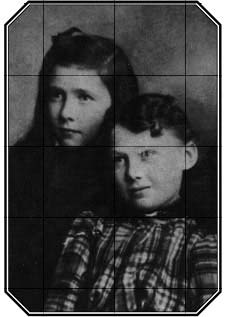
Maud Hart Lovelace Archive
Maud (right) and Bick (left) were lifelong friendsâhere they are at age ten
.
Â
Â

Collection of Sharla Scannell Whalen
The glass pitcher that Bick gave to Maud for her fifth birthday is now on display at the public library in Mankato
.
Â
Â
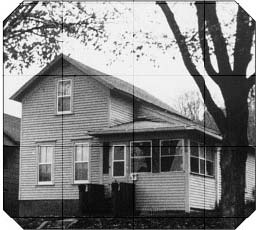
Collection of Sharla Scannell Whalen
Maud lived with her family in this little house at 333 Center Street
.
Â
Â
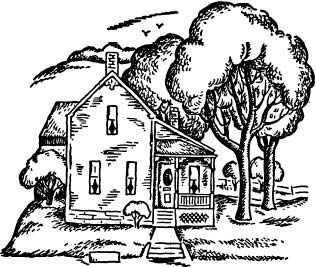
The Ray house, at 333 Hill Street, closely resembles Maud's
.
Â
Â
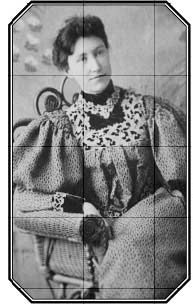
Maud Hart Lovelace Archive
Maud's mother, Stella Palmer Hart, was a schoolteacher before her marriage to Tom Hart
.
Â
Â
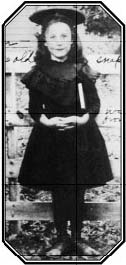
Maud Hart Lovelace Archive
In this photo, Kathleen Hart, Maud's older sister and the model for Julia Ray, is about eight years old
.
Â
Â
